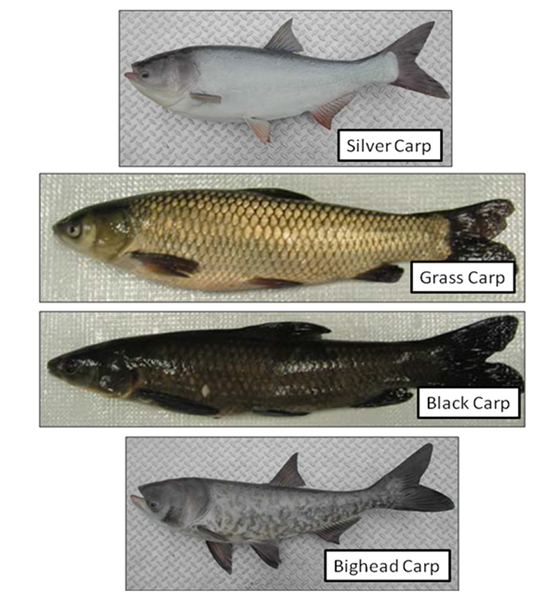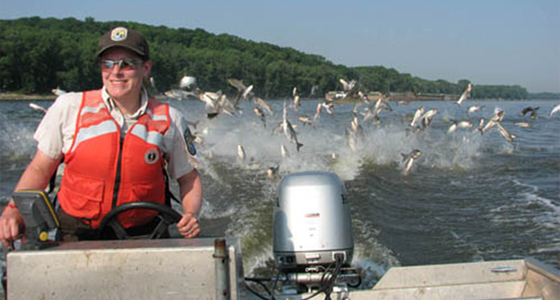Asian Carp
Kevin Rose | Smithsonian Environmental Research Center
Asian Carp is a common name usually used to describe several species of invasive fish in the U.S. Typically, this includes black carp (Mylopharyngodon piceus), bighead carp (Hypophthalmichthys nobilis), and silver carp (H. molitrix). Occasionally, grass carp (Ctenopharyngodon idella) is also considered an invasive species of Asian Carp. Silver Carp is also known as “Jumping Carp” because it jumps when disturbed by passing boats.

Asian Carp include Silver, Grass, Black, or Bighead Carp. Image from 4.
Carp can grow to very large sizes. For example, Bighead carp can grow to 110 pounds (50 kg) and Silver Carp can grow to over 60 pounds1 (27 kg).
Learn how to identify the different types of Asian Carps: How to Identify Asian Carp
Asian Carp were originally imported to the southern U.S. from China for use in aquaculture and water quality remediation to keep algal populations in check2. Bighead carp have been raised and sold as a live fish food and to keep aquaculture facilities clean since the early 1980s and Grass Carp have been stocked in many areas since the 1970s as a biological control for aquatic weeds as well as a live fish food product. Black Carp have been used as a biological control of snail-borne parasites in aquaculture since the early 1990s.
It is believed that both intentional and inadvertent releases established these species in the wild in many places. There is a large federal, state, and local effort focused at keeping Asian Carp out of the Great Lakes. It is feared that once invaded, Asian Carp will disrupt the Great Lakes ecosystems, reducing the value of sport fishing and out competing native fish species. The Great Lakes fishery is valued at over $7 billion annually3. Given the temperature, food resources, wetland, large areas for migration, and a lack of natural predators, it is expected that Asian Carp would expand quickly if they successfully established in the Great Lakes4. Asian Carp can outcompete native fish like ciscos, bloaters, and yellow perch, and reduce the number of fish that feed on these native species, such as trout and walleye5.
During the last 10 years, Asian Carp have been identified in most large rivers near the Great Lakes and many Midwestern lakes and reservoirs, including Lake Calumet, just five miles from Lake Michigan. Grass Carp are currently reported in 45 states (excluding Alaska, Rhode Island, Maine, Vermont, and Montana) primarily because they have been deliberately stocked in many places5.
The US Fish and Wildlife Service regulates Asian Carp under the Lacey Act, which prohibits the importation and interstate transport (except by permit) of Silver Carp2. Plans are underway to add Bighead and Black Carp to the list of regulated Asian Carp species2.

Silver Carp are known to jump when disturbed, such as by the passing of outboard boat engines. Jumping carp, which can weigh up to about 60 pounds, can be very dangerous. Image from 7.
Sources:
- Minnesota Department of Natural Resources. Bighead and silver carp (Hypophthalmichtyys nobilis & H. molitrix). View online
- Asian Carp Regional Coordinating Committee. 2021. Asian Carp Action Plan. View online
- ASA. 2008. Today’s angler: A statistical profile of anglers, their targeted species and expenditures. American Sportfishing Association, Alexandria, VA.
- Nico and Fuller. 1999. Spatial and Temporal Patterns of Nonindigenous Fish Introductions in the United States. Fisheries, 24: 16-27.
- Hansen, M.J. et al. The Asian Carp Threat to the Great Lakes. 2010. Great Lakes Fishery Commission. View online
- Survey of Invasive Fish on Illinois Waterway. U.S. Fish and Wildlife Service. View online









